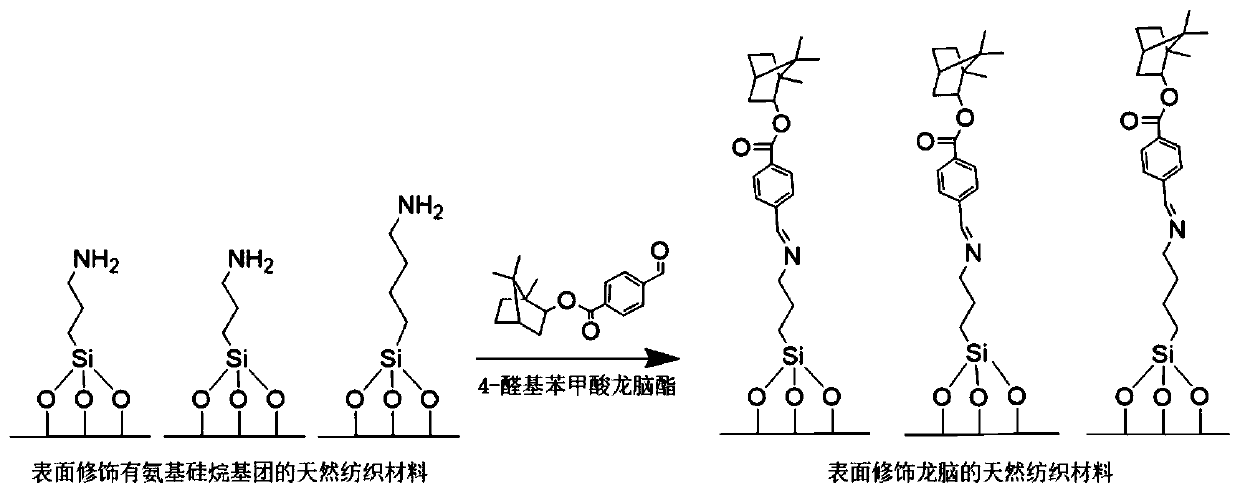Antibacterial natural textile material with surface modified borneol and its preparation method and application
A textile material and surface modification technology, applied in the field of antibacterial natural textile materials and their preparation, can solve the problems of unsustainable antibacterial effect, skin irritation, poor washability, etc., achieve good anti-adhesion effect, inhibit adhesion, and ensure safe use sexual effect
- Summary
- Abstract
- Description
- Claims
- Application Information
AI Technical Summary
Problems solved by technology
Method used
Image
Examples
Embodiment approach
[0054] As mentioned above, in the preparation methods of existing antibacterial textiles, some antibacterial agents are added to textile raw materials to make antibacterial fibers, and then spun into various antibacterial fabric products. High; Some are made of various antibacterial textiles by adding antibacterial agents in the finishing process of textile printing and dyeing. This method has the problems of poor antibacterial effect persistence and poor washability. However, the existing antibacterial agents all have the problems of not lasting antibacterial effect and poor washability, and there are also risks of toxicity, skin irritation and drug resistance caused by the release of antibacterial agents. In view of this, the inventor has carried out a large amount of research on antibacterial natural textile materials.
[0055] The present inventors have found that a new antibacterial strategy of surface stereochemistry can be used to prepare an antibacterial natural texti...
Embodiment 1
[0109] Soak the pretreated cotton textiles in an acetone solution with a concentration of 10vol% 3-aminopropyltriethoxysilane for 10 minutes, then take it out and heat it at 50°C for 2 hours to promote the formation of covalent bonds, and finally acetone thoroughly Excessive aminosilane was washed off and dried to obtain aminosilane-modified cotton textiles. Then soak it in an ethanol solution of D-borneol derivatives with a concentration of 0.02 g / mL, and soak for 1 hour at room temperature. Finally, the excess uncombined borneol derivatives are thoroughly washed with ethanol, and dried to obtain borneol-modified cotton textiles. The anti-bacterial adhesion rate is greater than 90%, and the anti-fungal effect is greater than 25 days (using experimental strains: Escherichia coli, Staphylococcus aureus, Aspergillus, Mucor, etc.).
Embodiment 2
[0111] Soak the pretreated cotton textiles in an acetone solution of 10vol% 3-aminopropyltrimethoxysilane for 10 minutes, then take it out and heat it at 60°C for 2 hours to promote the formation of covalent bonds, and finally wash it thoroughly with acetone Remove excess aminosilane and dry to obtain aminosilane-modified cotton textiles. Then soak it in an ethanol solution of L-borneol derivative with a concentration of 0.02g / mL, and soak it for 2h at room temperature. Finally, the excess uncombined borneol derivatives are thoroughly washed with ethanol, and dried to obtain borneol-modified cotton textiles. The anti-bacterial adhesion rate is greater than 90%, and the anti-fungal effect is greater than 25 days (using experimental strains: Escherichia coli, Staphylococcus aureus, Aspergillus, Mucor, etc.).
PUM
 Login to View More
Login to View More Abstract
Description
Claims
Application Information
 Login to View More
Login to View More - R&D
- Intellectual Property
- Life Sciences
- Materials
- Tech Scout
- Unparalleled Data Quality
- Higher Quality Content
- 60% Fewer Hallucinations
Browse by: Latest US Patents, China's latest patents, Technical Efficacy Thesaurus, Application Domain, Technology Topic, Popular Technical Reports.
© 2025 PatSnap. All rights reserved.Legal|Privacy policy|Modern Slavery Act Transparency Statement|Sitemap|About US| Contact US: help@patsnap.com



